|
|
|
Sort Order |
|
|
|
Items / Page
|
|
|
|
|
|
|
| Srl | Item |
| 1 |
ID:
191244


|
|
|
|
|
| Summary/Abstract |
The European Union (EU) recently declared its intention to implement a carbon border adjustment mechanism (CBAM) to address carbon leakage and competitiveness concerns associated with elevated climate ambitions in its Green Deal. Current literature points to uncertainties regarding the CBAM’s effectiveness and compatibility with international trade rules. This study numerically evaluates how alternative EU CBAM designs under various international reactions affect global and regional GHG emissions, outputs and trade flows.
|
|
|
|
|
|
|
|
|
|
|
|
|
|
|
|
| 2 |
ID:
113696


|
|
|
|
|
| Publication |
2012.
|
| Summary/Abstract |
The role of China in East Asia's recovery from the recent global financial and economic crisis highlights China's position as an engine of growth for this region. From the viewpoint of China, there are many potential gains from entering into free trade agreements (FTAs) with its neighbors, who collectively form a large and fast-growing market. In this paper, we qualitatively and quantitatively assess the four main permutations of China's FTAs with East Asian major economies: China-ASEAN, China-Japan, China-Korea and ASEAN+3. We compare the effects of these FTAs on China's output and welfare. Our comparative analysis shows that China will gain from all three bilateral FTAs, while gaining the most from the ASEAN+3. Because forming a region-wide FTA, such as the ASEAN+3, is expected to be gradual and difficult, China should continue to engage in bilateral FTAs as a medium-term and alternative strategy. However, in the long term, China should pursue a region-wide FTA.
|
|
|
|
|
|
|
|
|
|
|
|
|
|
|
|
| 3 |
ID:
144819
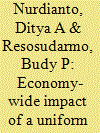

|
|
|
|
|
| Summary/Abstract |
The main goal of this study is to analyse the benefits and losses associated with cooperation among ASEAN members in mitigating their CO2 emissions, particularly by implementing a uniform carbon tax across ASEAN. To achieve this goal, this paper uses a multi-country computable generals equilibrium model for ASEAN, known as the Inter-Regional System of Analysis for ASEAN model. This study finds that the implementation of a carbon tax scenario is an effective means of reducing carbon emissions in the region. However, this environmental gain could come at a cost in terms of GDP contraction and reduction in social welfare, i.e. household income. Nevertheless, Indonesia and Malaysia can potentially gain from the implementation of a carbon tax as it counteracts price distortions due to the existence of heavy energy subsidies in these two countries.
|
|
|
|
|
|
|
|
|
|
|
|
|
|
|
|
| 4 |
ID:
136247
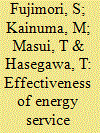

|
|
|
|
|
| Summary/Abstract |
A reduction of energy service demand is a climate mitigation option, but its effectiveness has never been quantified. We quantify the effectiveness of energy service demand reduction in the building, transport, and industry sectors using the Asia-Pacific Integrated Assessment/Computable General Equilibrium (AIM/CGE) model for the period 2015–2050 under various scenarios. There were two major findings. First, a 25% energy service demand reduction in the building, transport, and basic material industry sectors would reduce the GDP loss induced by climate mitigation from 4.0% to 3.0% and from 1.2% to 0.7% in 2050 under the 450 ppm and 550 ppm CO2 equivalent concentration stabilization scenarios, respectively. Second, the effectiveness of a reduction in the building sector׳s energy service demand would be higher than those of the other sectors at the same rate of the energy service demand reduction. Furthermore, we also conducted a sensitivity analysis of different socioeconomic conditions, and the climate mitigation target was found to be a key determinant of the effectiveness of energy service demand reduction measures. Therefore, more certain climate mitigation targets would be useful for the decision makers who design energy service demand reduction measures.
|
|
|
|
|
|
|
|
|
|
|
|
|
|
|
|
| 5 |
ID:
166475
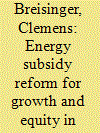

|
|
|
|
|
| Summary/Abstract |
Phasing out energy subsidies is high on the agenda of policymakers in several Middle Eastern and North African countries. The impact of such reform can vary widely depending on the country and policy. This paper contributes to the existing literature by examining the phasing out of energy subsidies in Egypt under alternative economic scenarios. In particular, we consider Egypt's short- and long-term economic adjustment under different assumptions on labor market flexibility, spending options of subsidy savings, and alternative social protection measures. Results from economy-wide model simulations suggest that energy subsidy cuts may hamper economic growth in the short term, but depending on the policy measure, will improve growth perspectives and household welfare in the longer term. Yet, findings also point to likely adverse impacts of the reform on household consumption in the short and longer run. To counteract such negative impacts, targeted social protection measures should be continued and scaled up in parallel with the phasing out of energy subsidies.
|
|
|
|
|
|
|
|
|
|
|
|
|
|
|
|
| 6 |
ID:
177383
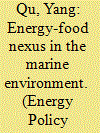

|
|
|
|
|
| Summary/Abstract |
The rapid development of offshore wind farms (OWFs) has stimulated debate about its overall socioeconomic impacts. Expanding the scale of OWFs increases the availability and affordability of electricity but could displace existing fishing activities and reduce food supply. To evaluate these impacts from a macroeconomic perspective, a computable general equilibrium (CGE) model is developed, using Scotland as a case study. A particular focus is placed on the disaggregated electricity and seafood sectors, their interconnectedness from an energy-food nexus perspective, and the distributional effects across household groups. This paper explores, from macroeconomic perspective, the trade-offs in the energy-food nexus between expanding OWFs and the seafood sectors, together with the impacts on food and energy security. The results suggest that, through economic linkages, increasing the number of OWFs would have a negative, but limited, effect on seafood production sectors. However, the falling cost of electricity from OWFs would have a positive impact on the economy overall and benefit lower income households, contributing to a reduction in fuel poverty. The model results raise the awareness of nexus linkages between OWFs and seafood production and are applicable to policies involving the development of other offshore renewables.
|
|
|
|
|
|
|
|
|
|
|
|
|
|
|
|
| 7 |
ID:
169861
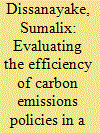

|
|
|
|
|
| Summary/Abstract |
Using the energy-environmental version of the Global Trade Analysis Project, this study compares the effects of three carbon emissions mitigation strategies – a carbon tax, a fuel tax and an emissions trading scheme (ETS) to combat the intended emissions target for Indonesia, a large emitting developing country. Although the fuel tax was found to raise economic growth by 0.29% in 2030, the carbon tax and ETS which reduce economic growth by about 0.11% have less adverse effects on inflation, welfare loss, wage decline, and employment loss. Unlike the fuel tax, the carbon tax and ETS are also likely to promote substitution towards renewable energy given the massive increase in the price of coal of over 100% due to the carbon tax and ETS. To meet Indonesia's emissions target, a carbon tax of US$36/ton of CO2 is needed. The carbon tax which is simpler and more swiftly implementable is the more practical choice compared to the ETS in the short to medium term for developing countries with political economy constraints in their energy and transportation sectors.
|
|
|
|
|
|
|
|
|
|
|
|
|
|
|
|
| 8 |
ID:
149979


|
|
|
|
|
| Summary/Abstract |
With over 200 countries reaching an agreement with the stated aim of restricting global warming to “well below 2° C above pre-industrial levels” – the most comprehensive climate change agreement was recently signed. Though most of the hard work lies ahead, it marks an important first step for the collective global community to address climate change. Fossil fuels continue to remain one of the largest contributors to greenhouse gas emissions and for many developing countries high levels fossil fuels continues to enable an overconsumption of fossil fuels. Given the sensitivity of governments to subsidy reforms, this study examines the household welfare implications of the removal of fossil fuel subsidies. It finds that while welfare implications are unambiguously positive for government the results are mixed for private households, although in an overwhelming majority of cases, the results are positive. However, even in the cases where the welfare implications are negative for private households we find that it is possible for governments to carry out the reforms in such a way as to be welfare improving to households incomes by compensating them with some of the fiscal savings gained from the subsidy reform.
|
|
|
|
|
|
|
|
|
|
|
|
|
|
|
|
| 9 |
ID:
176102


|
|
|
|
|
| Summary/Abstract |
There are cross subsidies in China's power industry and there is a gap between supply cost and the sales price of electricity to residents and enterprises. Enterprises pay for part of residents' electricity bills. As cross subsidies always have been criticized, this paper simulates counterfactual scenarios of removing cross subsidy by applying a dynamic recursive computable general equilibrium model. Based on the scenario analysis, the elimination of cross subsidy will have positive impact on economic performance, but negative on CO2 mitigation, industrial structure, and social welfare. Eliminating cross subsidies can reduce commodity prices, improve the competitiveness of enterprises, especially power-intensive enterprises. However, China is somehow an export-oriented country. Only a part of the benefits of the decrease in the product price is obtained by domestic households. Maybe removing cross subsidies is not a good policy in this kind of countries. However, under the background of power system reform, cross subsidy may not last long, and the price will not be regulated. With the marketization of electricity trading, appropriate imposed environmental tax or carbon tax will be more conducive to China's low-carbon development.
|
|
|
|
|
|
|
|
|
|
|
|
|
|
|
|
| 10 |
ID:
119207
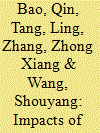

|
|
|
|
|
| Publication |
2013.
|
| Summary/Abstract |
Carbon-based border tax adjustments (BTAs) have recently been proposed by some OECD (Organization for Economic Co-operation and Development) countries to level the carbon playing field and target major emerging economies. This paper applies a multi-sector dynamic, computable general equilibrium (CGE) model to estimate the impacts of the BTAs implemented by the US and EU on China's sectoral carbon emissions. The results indicate that BTAs will decrease export prices and transmit the effects to the whole economy, affecting sectoral output and demand from both the supply side and demand side. On the supply side, sectors might move away from exporting towards the domestic market, thereby increasing sectoral supply, while on the demand side, the domestic income may be strikingly cut down due to the decrease in export price, decreasing sectoral demand. Furthermore, such shrinkage of demand may similarly reduce energy prices, which would lead to an energy substitution effect and somewhat stimulate carbon emissions. Depending on the relative strength of the output-demand effect and energy substitution effect, sectoral carbon emissions and energy demands will vary across sectors, with increases, decreases or shifts in different directions. These results suggest that an incentive mechanism to encourage the widespread use of environment-friendly fuels and technologies will be more effective than BTAs.
|
|
|
|
|
|
|
|
|
|
|
|
|
|
|
|
| 11 |
ID:
116756


|
|
|
|
|
| Publication |
2012.
|
| Summary/Abstract |
This paper explores how China's household consumption patterns over the period 2005-2050 influence the total energy demand and carbon dioxide (CO2) emissions in two baseline scenarios, and how it influences carbon prices as well as the economic cost in the corresponding carbon mitigation scenarios. To this end we first put forward two possible household consumption expenditure patterns up to 2050 using the Working-Leser model, taking into account total expenditure increase and urbanization. For comparison, both expenditure patterns are then incorporated in a hybrid recursive dynamic computable general equilibrium model. The results reveal that as income level increases in the coming decades, the direct and indirect household energy requirements and CO2 emissions would rise drastically. When household expenditure shifts from material products and transport to service-oriented goods, around 21,000 mtce1 of primary energy and 45 billion tons of CO2 emissions would be saved over the 45-year period from 2005 to 2050. Moreover, carbon prices in the dematerialized mitigation scenario would fall by 13% in 2050, thus reducing the economic cost.
|
|
|
|
|
|
|
|
|
|
|
|
|
|
|
|
| 12 |
ID:
093504
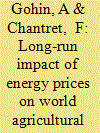

|
|
|
|
|
| Publication |
2010.
|
| Summary/Abstract |
The world prices of some food and energy products have followed similar large swings in recent years. We investigate the long-run relationship between these prices using a world Computable General Equilibrium model with detailed representations of food and energy markets. Particular attention is paid to specifying macro-economic linkages which have often been overlooked in recent analysis and debate. We find that the omission of these macro-economic linkages has a substantial bearing on this relationship. A positive relationship due to the cost push effect has been identified in most analysis, but we find that the introduction of the real income effect may indeed imply a negative relationship between world food and energy prices.
|
|
|
|
|
|
|
|
|
|
|
|
|
|
|
|
| 13 |
ID:
177149


|
|
|
|
|
| Summary/Abstract |
Reunion Island, similar to most insular regions, is ruled by a carbon-based economy that is heavily dependent on fossil fuels. In recent years, the energy transition towards a low-carbon economy has become the watchword of this French overseas region, with the objective of a 100% renewable energy mix by 2030. Reducing fossil fuel use while maintaining economic growth is an important issue for all countries but is even more important for island territories with structural and geographical handicaps. Energy transition and drastic greenhouse gas emission reductions represent costs and opportunities that need to be quantified. This research paper assesses the environmental and macroeconomic effects of the carbon price policy introduced in France to meet the target of the Paris Agreement. The acceptability of the tax significantly depends on the possibility of recycling tax revenues. Different schemes for recycling tax revenues are considered in simulations. The methodology used is a computable general equilibrium (CGE) model for Reunion Island (GetRun-NRJ) that takes into account all island specificities. The results show that the carbon tax enables substitutions between fossil and renewable energy production and reduces CO2 emissions. However, the tax has negative effects on the aggregate economy. The implemented tax revenue recycling compensation mechanisms mitigate the negative impacts, but the results differ significantly, as the recycling schemes do not support the same economic actors.
|
|
|
|
|
|
|
|
|
|
|
|
|
|
|
|
| 14 |
ID:
113421


|
|
|
|
|
| Publication |
2012.
|
| Summary/Abstract |
The sharp rise in oil and food prices in 2007 and 2008 caused negative impacts on poverty and economic growth in many oil and food importing developing countries. Some analysts believe that these countries are under stress again due to a rise in crude oil prices, to a two-and-a-half year high in March 2011, which has also been partly responsible for higher food prices in recent months. However, there is a limited body of empirical evidence available from developing countries on the impact of high oil prices on growth in general and household poverty in particular. In this study, Sri Lanka is used as a case study and a computable general equilibrium (CGE) approach is adopted as an analytical framework to explore the growth and poverty impacts of high oil prices. The results suggest that urban low income households are the group most adversely affected by high global oil prices, followed by low income rural households. In contrast, estate low income households are the least affected out of all low income households. The energy intensive manufacturing sector and services sector are affected most compared to the agricultural sector.
|
|
|
|
|
|
|
|
|
|
|
|
|
|
|
|
| 15 |
ID:
160816


|
|
|
|
|
| Summary/Abstract |
This study uses a computable general equilibrium approach to investigate the impact of high global food and agricultural commodity prices and two mitigation options (a rise in agricultural input subsidies and an improvement in agricultural productivity) on poverty and economic performance of Malaysia. Simulated results showed that, as a whole, the high global food price has a negative impact on the economic growth of Malaysia. It decreases real gross domestic product of Malaysia by 0.53%. Although the food price hike initially increases poverty in urban areas, it would significantly decrease the poverty of rural and noncitizen households. However, both mitigation options can reduce the negative impact of the shock on the poverty and economic growth of Malaysia. The agricultural subsidy rise option cannot reduce the poverty level of all household groups, whereas the productivity improvement option can alleviate the poverty level of all household groups. In conclusion, results suggest that the agricultural productivity improvement option is more effective than the agricultural subsidy rise option to mitigate the negative impact of global food price shocks on the economy and poverty of Malaysia.
|
|
|
|
|
|
|
|
|
|
|
|
|
|
|
|
| 16 |
ID:
166391
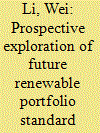

|
|
|
|
|
| Summary/Abstract |
The shortage of traditional energy sources and environmental pollution caused by the consumption of fossil fuels have become increasingly prominent, and many countries regard the development of renewable energy as important for ensuring energy conservation and emission reductions. In addition, renewable portfolio standard is important for China to achieve energy transition. The Chinese government is actively promoting the construction of a renewable portfolio standard system. Considering different renewable energy development targets for renewable portfolio standards, this paper establishes a dynamic computable general equilibrium (CGE) model to research the impacts of achieving various policy targets. The main simulation results are as follows. Promoting renewable sources would have a slightly negative impact on macroeconomics. For each additional percentage point in the share of renewable energy generation in 2030, the loss of GDP would increase by approximately 9.11 billion RMB. A renewable energy policy could be also conducive to carbon emission reduction and energy structure adjustment. Certainly, the proportion of renewable energy in the total power generation should be approximately 34% to achieve the government target for non-fossil fuels to account for approximately 20% of the primary energy consumption by 2030.
|
|
|
|
|
|
|
|
|
|
|
|
|
|
|
|
| 17 |
ID:
090112


|
|
|
|
|
| Publication |
2009.
|
| Summary/Abstract |
The current global financial and economic crisis is giving new life to initiatives that promote closer economic integration among East Asian countries. A significant example is the ASEAN-China Free Trade Area (ACFTA), which is set to come into effect around 2010. ACFTA aims to boost trade between two economies that are partners as well as competitors: ASEAN and China. In the present paper, we use insights from customs union theory in a qualitative analysis considering whether ACFTA would benefit both sides. We also apply a computable general equilibrium model to perform a quantitative analysis of the same issue. Both our qualitative and quantitative analyses provide grounds for guarded optimism regarding ACFTA's prospects as a vehicle for strengthening the economic partnership between ASEAN and China.
|
|
|
|
|
|
|
|
|
|
|
|
|
|
|
|
|
|
|
|
|